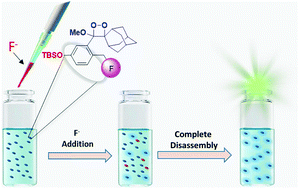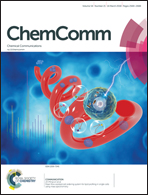Chemiluminescence molecular probe with intrinsic auto-inductive amplification: incorporation of chemiexcitation in a quinone-methide elimination†
Abstract
A new signal amplification system with an auto-inductive mode of action and distinct chemiluminescence output was developed. The system is composed of a unique structural motif that combines a chemiexcitation mechanism with a quinone-methide elimination into a signal building block. As demonstrated with a probe designed to detect fluoride, an auto-inductive chemiluminescence signal amplification was obtained through self-immolative disassembly and light emission mechanisms.

- This article is part of the themed collection: RSC papers by GRC Bioanalytical Sensors 2018 Speakers


 Please wait while we load your content...
Please wait while we load your content...